Most houseplants are intended to be displayed on tabletops and shelves, but if you want to squeeze more plants into your collection and add vertical interest to your home’s décor, trailing houseplants are the way to go.
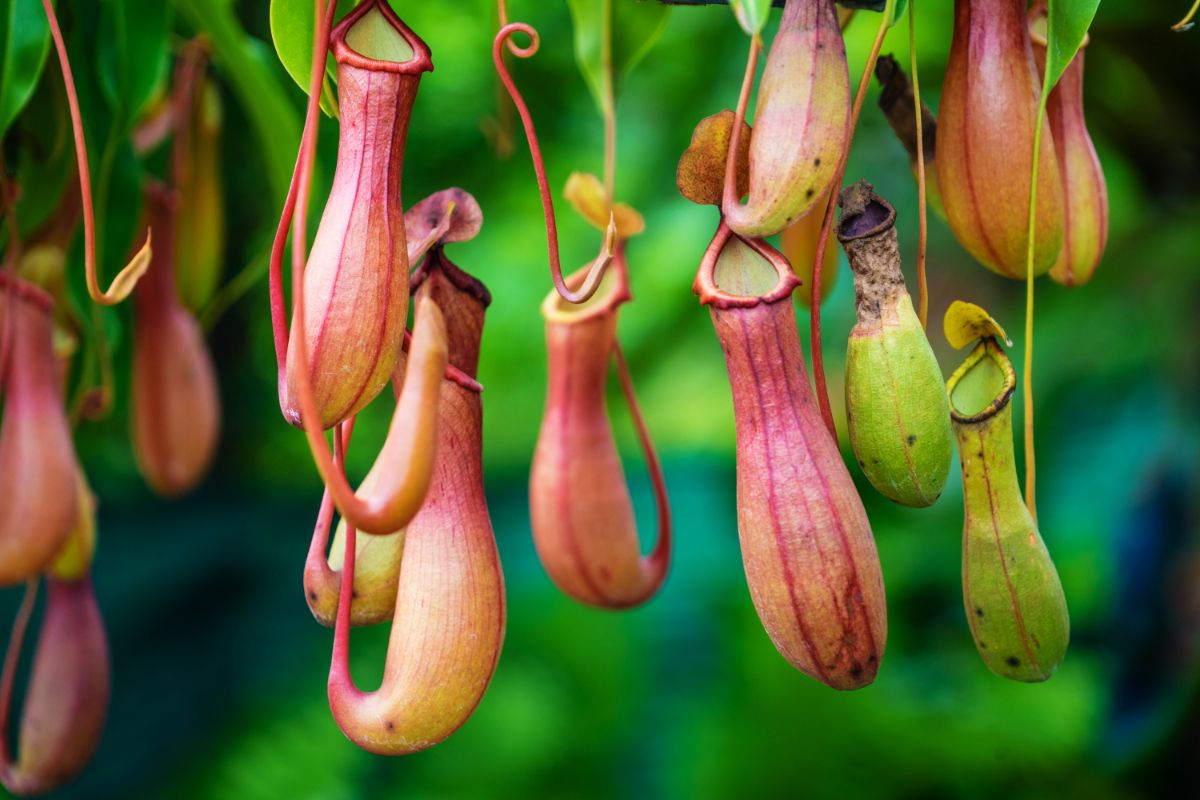
From pothos to hoyas, there’s a wide variety of trailing or vining plants that look spectacular in hanging baskets and planters. To discover the best plants to hang from windows or tall shelves, check out our simple guide below!
Jump to:
- 20 trailing houseplants to grow in hanging baskets
- 1. Pothos (Epipremnum aureum)
- 2. Philodendron (Philodendron spp.)
- 3. Inch plant (Tradescantia zebrina)
- 4. Swedish ivy (Plectranthus verticillatus)
- 5. Prayer plant (Maranta leuconeura)
- 6. Sweet potato vine (Ipomoea batatas)
- 7. Purple heart (Tradescantia pallida)
- 8. String of pearls (Senecio rowleyanus)
- 9. English ivy (Hedera helix)
- 10. String of dolphins (Curio × peregrinus)
- 11. Chenille plant (Acalypha hispida)
- 12. Spider plant (Chlorophytum comosum)
- 13. String of hearts (Ceropegia woodii)
- 14. Monkey’s tail cactus (Cleistocactus colademononis)
- 15. Hoya (Hoya spp.)
- 16. Burro’s tail (Sedum morganianum)
- 17. Fishbone cactus (Epiphyllum anguliger)
- 18. Grape ivy (Cissus alata)
- 19. Pitcher plant (Nepenthes spp.)
- 20. Spanish moss (Tillandsia Usneoides)
- Summary
20 trailing houseplants to grow in hanging baskets
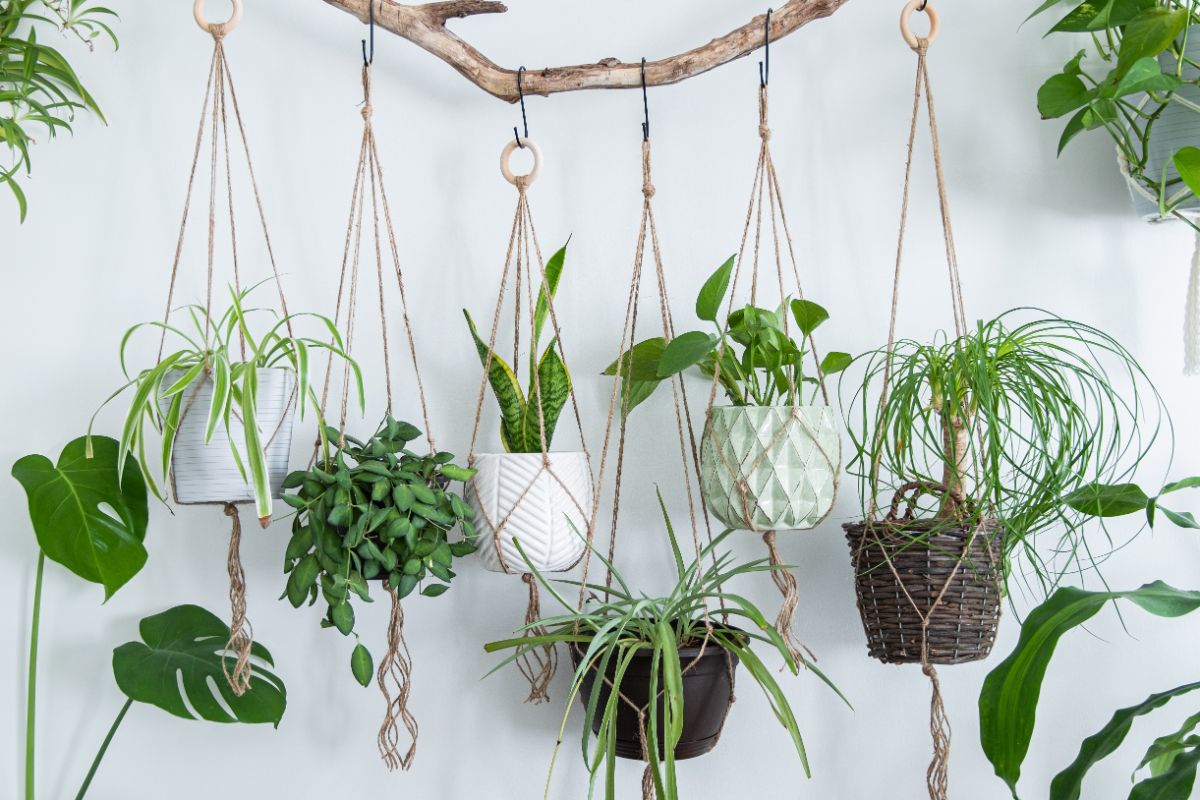
Some of the best plants for hanging baskets are trailing vines, like pothos or English ivy. But other plants with cascading growth habits create a striking silhouette in window planters too. In the list below, you’ll find a variety of plants in different colors and shapes, as well as some beginner-friendly and more advanced plants to suit the needs of any indoor gardener.
1. Pothos (Epipremnum aureum)
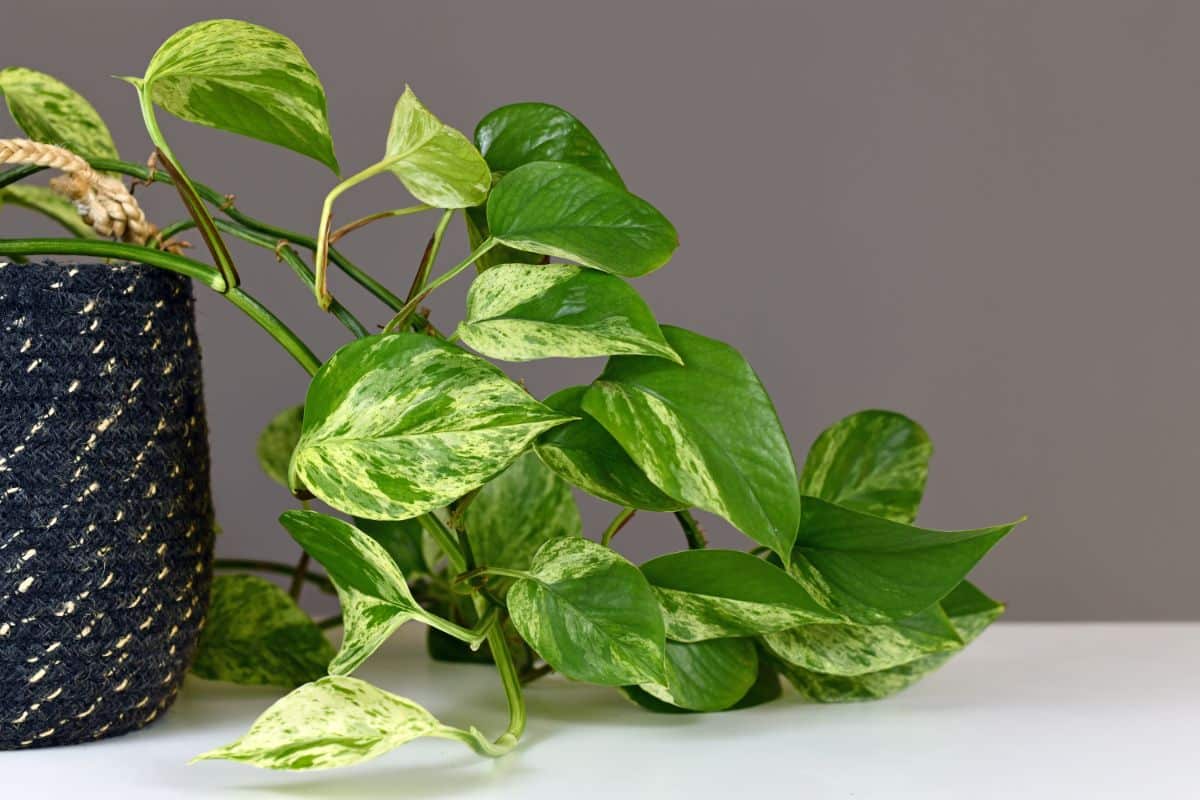
| Plant name: | Pothos |
| Light requirements: | Bright, indirect light to low light |
| Water requirements: | Moderate |
| Pet safe? | No |
| Special features: | Easily propagated; Low maintenance; Many varieties to choose from |
Also known as “devil’s ivy” for its nearly indestructible nature, pothos is a top plant to try if you’re new to keeping houseplants. Pothos plants are so hardy they can thrive in both bright, indirect light, or low light, and they can even grow in water! However, most plant parents collect pothos because of their vining growth habit, which looks spectacular in hanging baskets.
Pothos plants come in a range of colors, including ‘Neon pothos’ with bright, chartreuse green leaves and ‘Golden pothos,’ which has speckled green and yellow leaves. These plants rarely flower indoors, but they produce vigorous vines that can grow 10’ long or more. Some plant collectors even train pothos vines to climb up walls and across the ceiling with fishing line or small hooks!
2. Philodendron (Philodendron spp.)
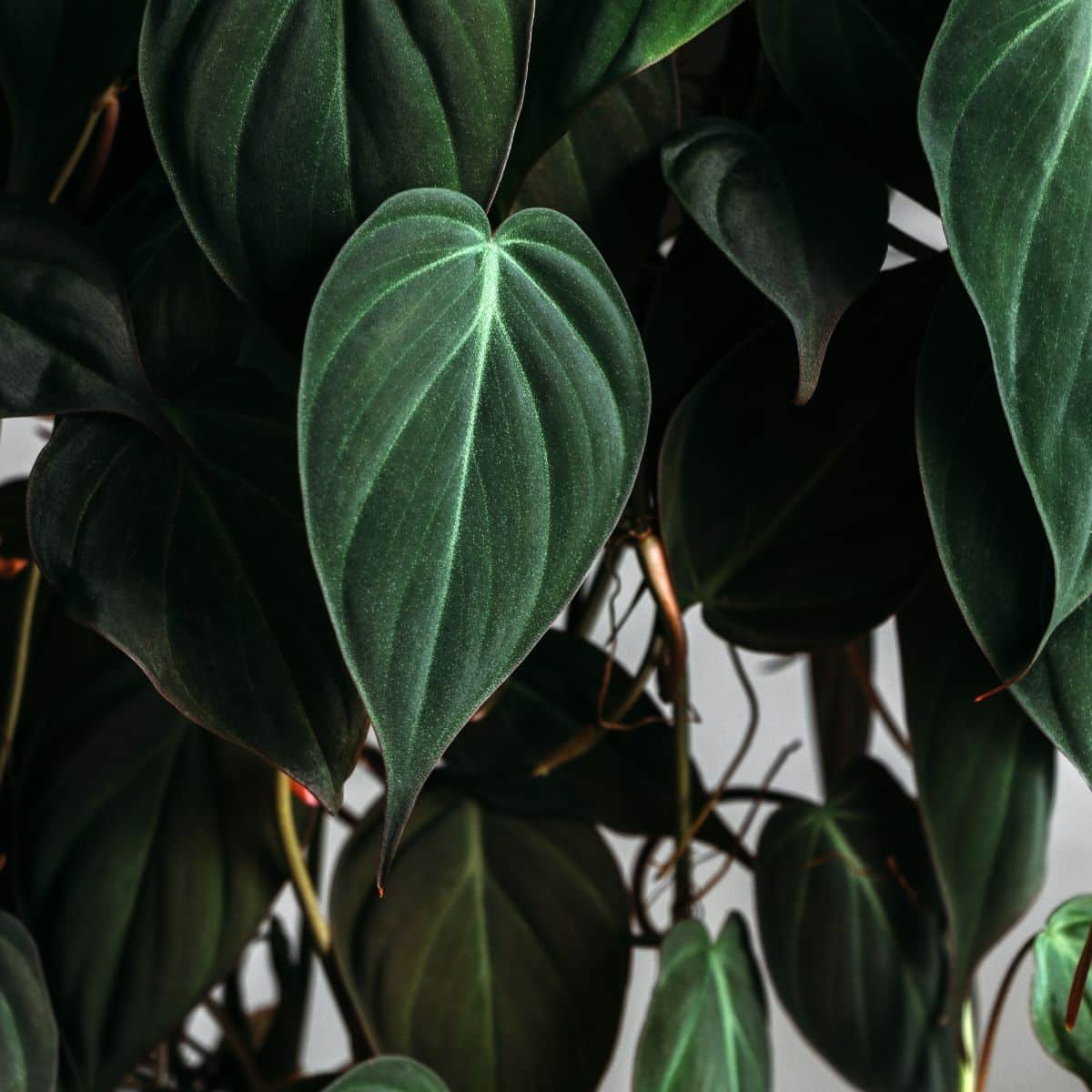
| Plant name: | Philodendron |
| Light requirements: | Bright, indirect light to low light |
| Water requirements: | Moderate |
| Pet safe? | No |
| Special features: | Easily propagated; Many varieties to choose from |
Some philodendron plants have upright growth habits that make them difficult to keep in hanging baskets. But if you try out vining philodendron varieties, like the ‘Heart Leaf philodendron’ or the ‘Velvet leaf philodendron,’ you’ll have a gorgeous foliage plant that will be the highlight of any hanging plant display.
Vining philodendrons look a lot like pothos, although their leaves have slightly different shapes and colors. These plants also root well in water, allowing you to sprout cuttings to share with friends. Try potting up several philodendron vines in a single hanging basket to give your plant a fuller appearance.
3. Inch plant (Tradescantia zebrina)
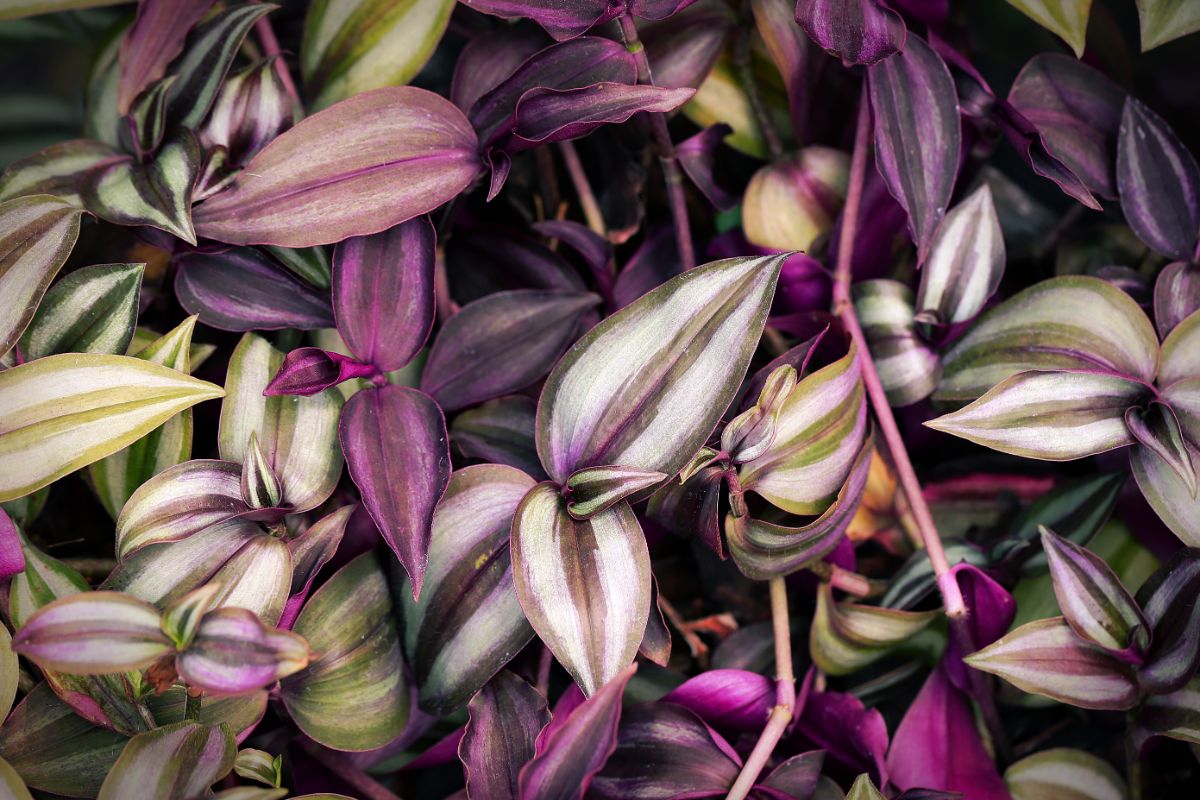
| Plant name: | Inch plant |
| Light requirements: | Bright, indirect light |
| Water requirements: | Moderate |
| Pet safe? | No |
| Special features: | Easily propagated; Flowers reliably |
Also known as the wandering dude plant, inch plants are impressive foliage plants with boldly colored, striped leaves in purple, green, and silver hues. These plants have semi-succulent stems, which sprout easily in water. However, the stems are quite delicate, and they break easily when jostled or handled.
One solution to preventing broken stems on inch plants is to keep these plants out of the way in hanging baskets. As they grow, inch plants form an attractive, mounding habit that can make a big impact in any window, and these plants also reliably flower small, pinkish-purple blooms. Just make sure you keep inch plants in well-draining pots, as they can be prone to root rot.
4. Swedish ivy (Plectranthus verticillatus)

| Plant name: | Swedish ivy |
| Light requirements: | Bright, indirect light |
| Water requirements: | Moderate |
| Pet safe? | Yes |
| Special features: | Easily propagated; Pet safe |
As charming as pothos and philodendrons vines are, they aren’t safe for pets. But if you’re on the hunt for a vining plant that’s non-toxic, Swedish ivy has a similar look to pothos, but it’s perfectly pet-friendly!
Swedish ivy plants have glossy leaves with serrated margins that add a nice, textured look to houseplant displays. While these plants can be kept as tabletop specimens, they really come alive when they’re allowed to trail out of hanging baskets. Mature plants grow about 3’ long, and they can even flower in autumn if you hang your plant outdoors during the summer months.
5. Prayer plant (Maranta leuconeura)
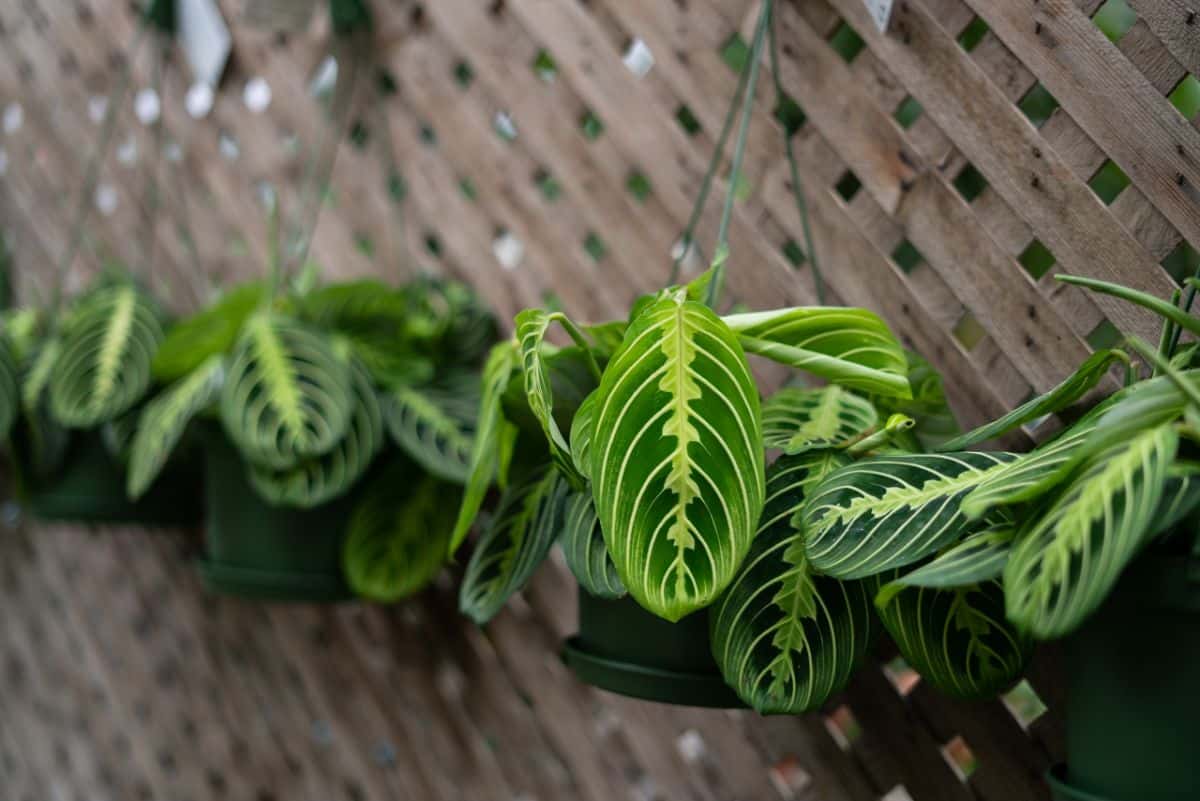
| Plant name: | Prayer plant |
| Light requirements: | Bright, indirect light |
| Water requirements: | Moderate |
| Pet safe? | Yes |
| Special features: | Colorful leaves; Flowers reliably; Pet safe |
Prayer plants aren’t true vining plants, but their stems do grow long and cascade beautifully over the edges of plant pots and hanging baskets. While you can find prayer plants in different colors, the red prayer plant is one of the most common and colorful prayer plant varieties. This plant features flashy leaves ornamented with shades of green and contrasting red stripes that make the plant’s foliage really pop!
When properly maintained, prayer plants produce tiny purple flowers in spring or summer that accentuate the plant’s colorful leaves. These plants also have the unique habit of moving with light, and their leaves turn upwards in the evening to conserve moisture. Prayer plants tend to grow best with extra humidity, but they will still grow happily, even without an added humidifier.
6. Sweet potato vine (Ipomoea batatas)
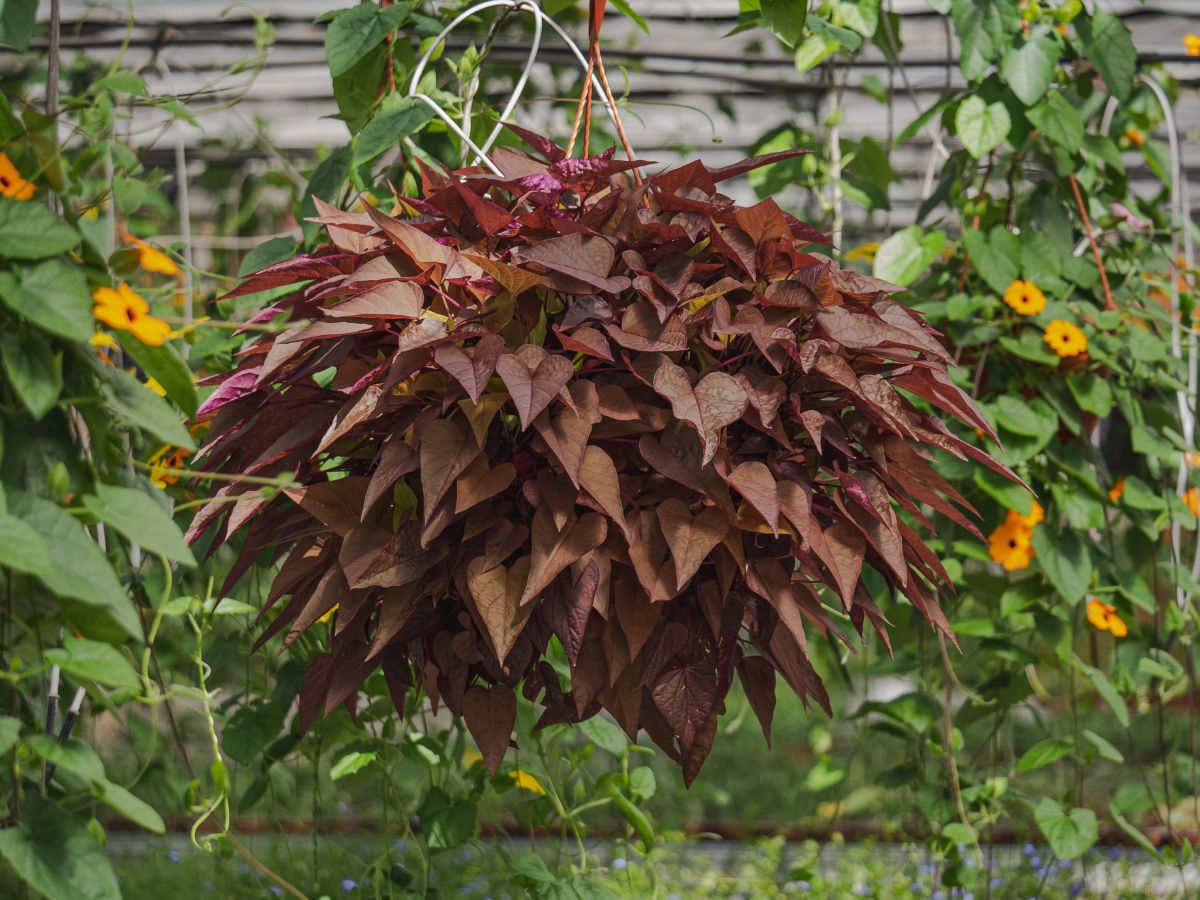
| Plant name: | Sweet potato vine |
| Light requirements: | Bright light to bright, indirect light |
| Water requirements: | Moderate |
| Pet safe? | No |
| Special features: | Colorful leaves; Grows indoors or outdoors; Big flowers |
Sweet potato vines are often thought of as outdoor plants, and they’re a common sight in container gardens where their vining growth is used as a “spiller element.” But if you’re looking for an easy-care plant to use indoors in a hanging basket, you may want to give sweet potato vines a try.
Sweet potato vines are actually the same plant as edible sweet potatoes, although these vines have been carefully bred for their ornamental appeal rather than their flavor. Mature plants can produce small tubers, but they aren’t as tasty as sweet potatoes intended for garden growing. But we love ornamental sweet potatoes for their showy, bright green or purple leaves and their trumpet-shaped, purple flowers that are difficult to resist!
7. Purple heart (Tradescantia pallida)
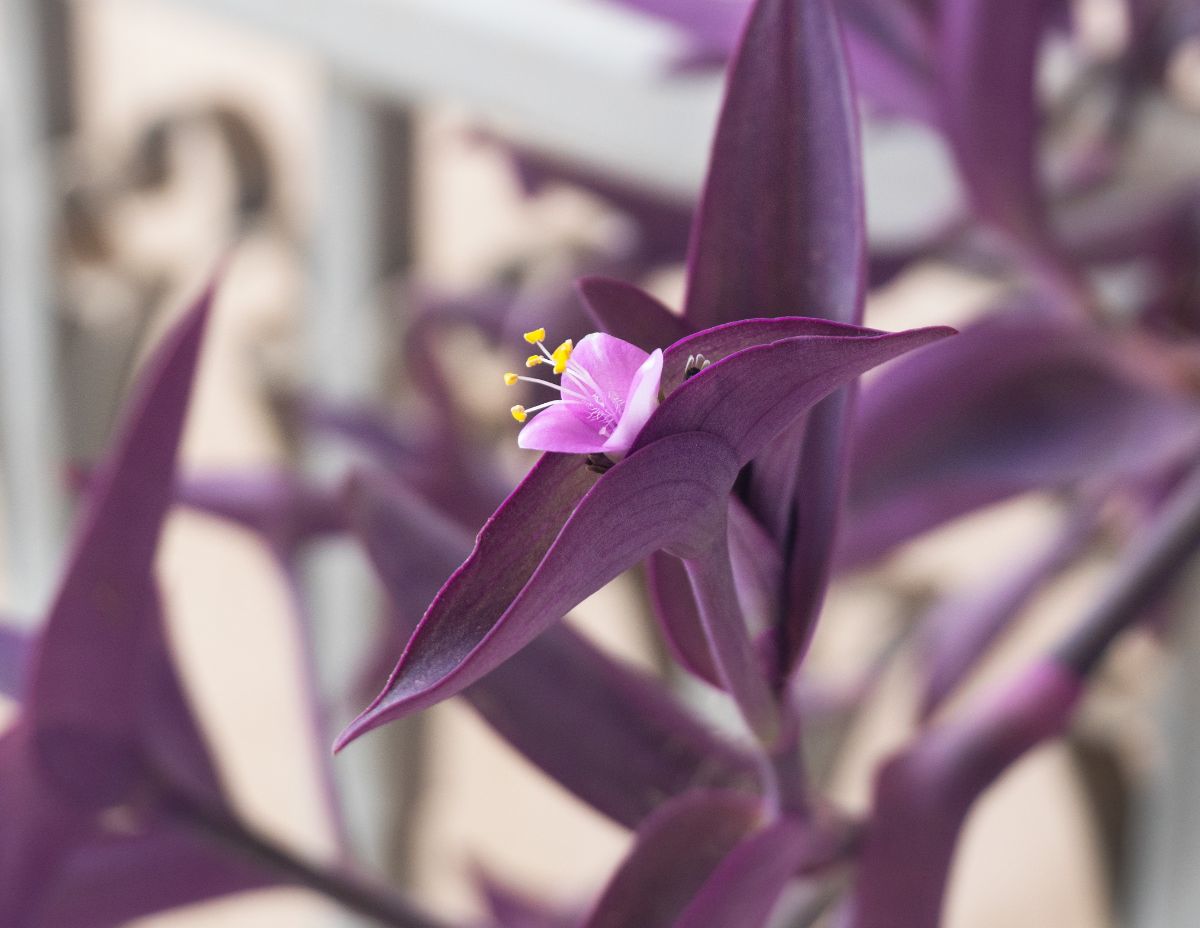
| Plant name: | Purple heart |
| Light requirements: | Bright light |
| Water requirements: | Moderate |
| Pet safe? | No |
| Special features: | Easily propagated; Grows indoors or outdoors |
Purple heart is a close relative of inch plants, and it has a similarly undemanding nature. In warm climates, the purple heart plant is often grown outdoors in containers or as a groundcover, but its trailing vines are ideal for indoor hanging baskets too!
Purple hearts grow best in bright light, which supports their vivid purple leaves. In lower-light situations, purple hearts may turn green, and they are less likely to flower. Like many other vining plants, the purple heart is extremely easy to propagate in both soil and water, so if you prune your plant, don’t throw your cuttings away!
8. String of pearls (Senecio rowleyanus)
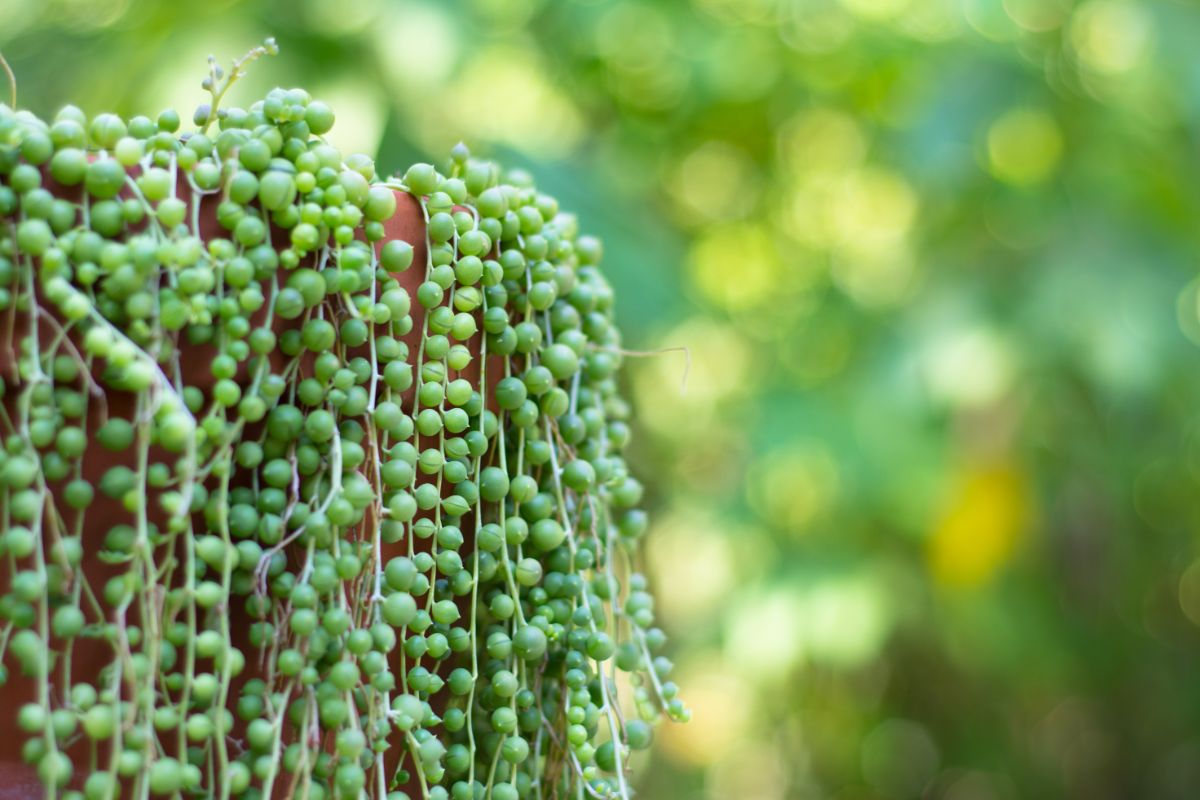
| Plant name: | String of pearls |
| Light requirements: | Bright, indirect light |
| Water requirements: | Low |
| Pet safe? | No |
| Special features: | Low watering needs |
Next to monstera, a string of pearl plants are one of the most photogenic houseplants you can find! A string of pearls are succulent plants that produce long, trailing stems bursting with globular leaves, which the plant uses for water storage. Like other succulents, the string of pearls doesn’t need a lot of water, but it can benefit from extra humidity.
As far as indoor plants go, a string of pearls can be a bit trickier to keep, but that’s mostly due to watering issues. As these plants can be susceptible to root rot, be careful not to overwater your plant and only water the string of pearls when the soil feels dry to the touch. If you’re lucky, the string of pearls will also reward you with adorable white flowers in summer that look a bit like Dutch clover blooms.
9. English ivy (Hedera helix)
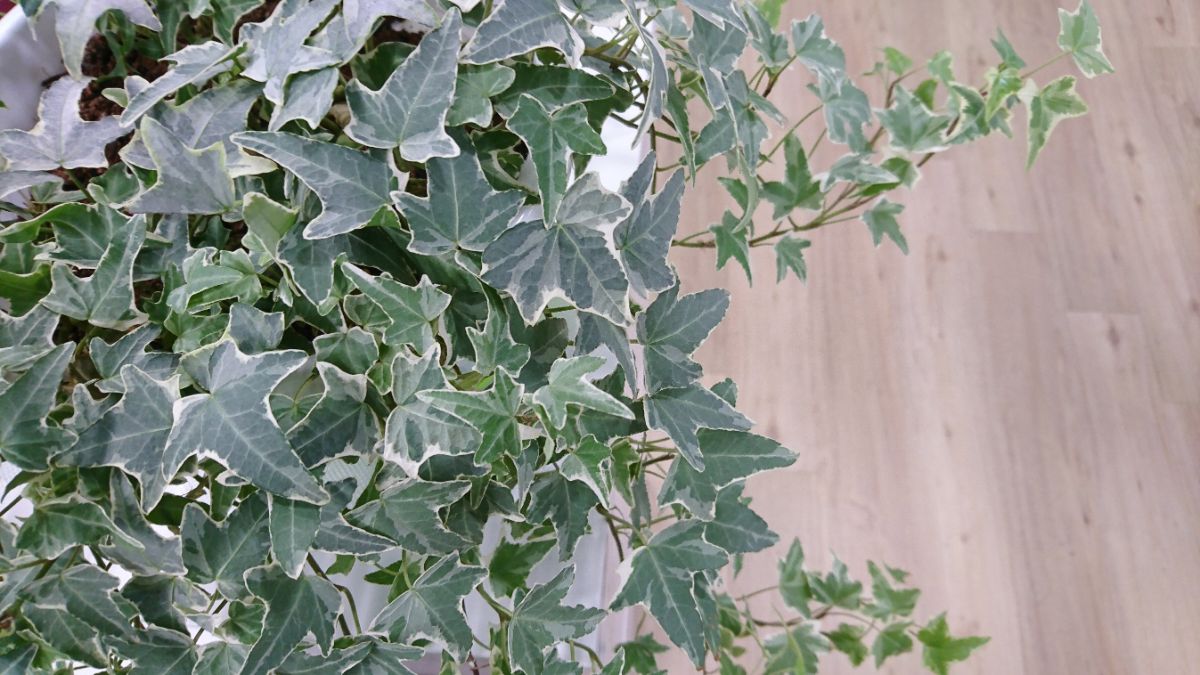
| Plant name: | English ivy |
| Light requirements: | Bright light to medium light |
| Water requirements: | Moderate |
| Pet safe? | No |
| Special features: | Low maintenance |
English ivy is a bit infamous when kept outdoors as it can become invasive in some areas. However, if you grow English ivy as a houseplant, it is generally much easier to manage, although its vigorous roots can damage plaster! For this reason, if you want to keep English ivy in your home, be sure to prevent your plant from climbing up your walls.
In general, English ivy plants have green, palmate leaves with a glossy and slightly leathery feel. But if you don’t mind browsing a few plant nurseries, you can usually find variegated English ivy plants with bright white and green leaves for extra interest. While English ivy grows beautifully in hanging baskets, it is also a top choice for terrariums as this plant does like a bit of extra humidity.
10. String of dolphins (Curio × peregrinus)
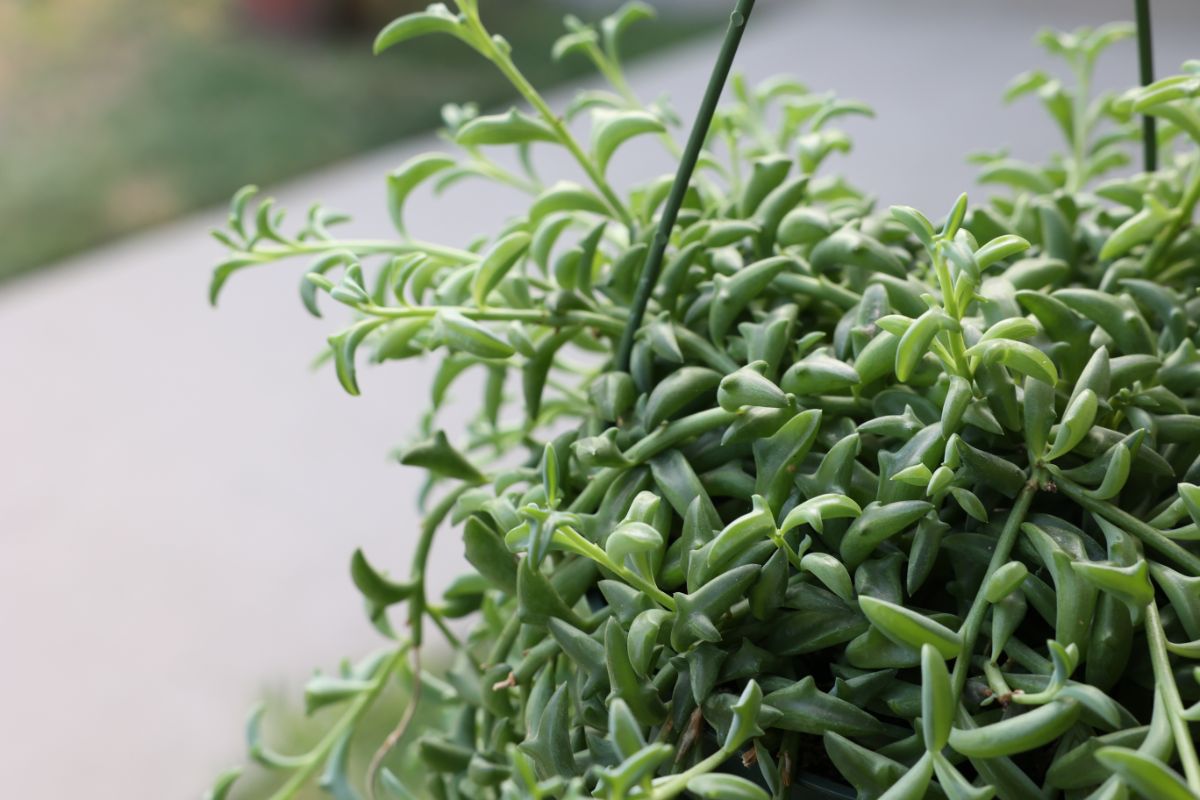
| Plant name: | String of dolphins |
| Light requirements: | Bright, indirect light |
| Water requirements: | Low |
| Pet safe? | No |
| Special features: | Low watering needs |
Made by crossing a string of pearl plants with candle plants, a string of dolphins are funky, trailing succulents that are must-haves for anyone who adores unique plants. Like a string of pearls, a string of dolphins develops long, trailing vines as it matures. But this plant has curious leaf forms that look a bit like tiny dolphins in mid-jump!
Like a string of pearls, a string of dolphins uses its fleshy leaves for water storage, so it’s more drought tolerant than many other houseplants. These plants should be potted in well-draining soil intended for succulents and cacti, and care should be taken to avoid overwatering them. Occasionally, a string of dolphins can also bloom, but their flowers are inconspicuous and fade quickly.
11. Chenille plant (Acalypha hispida)
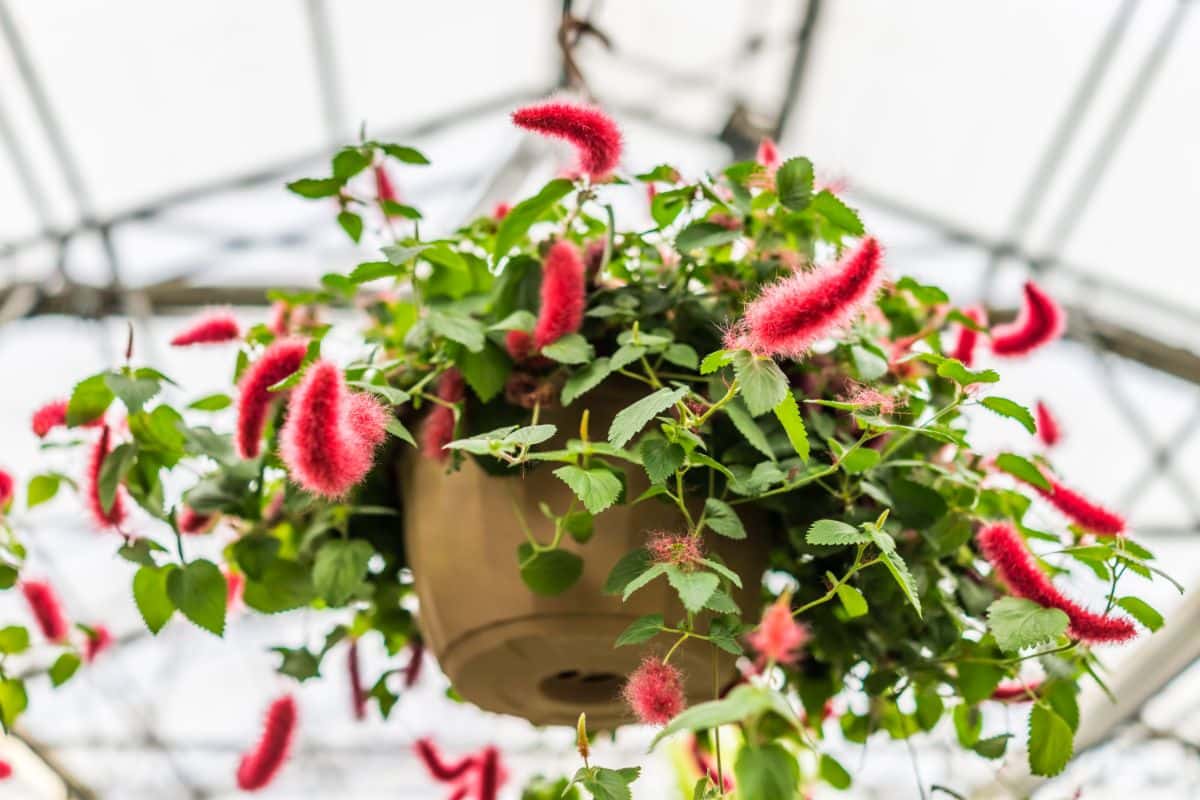
| Plant name: | Chenille plant |
| Light requirements: | Bright light |
| Water requirements: | Moderate |
| Pet safe? | No |
| Special features: | Furry flowers |
A close relative of crotons and poinsettia, the chenille plant is a member of the spurge family, and it can be grown outdoors or indoors. As a houseplant, chenille plants have a very distinct look thanks to their fuzzy, red catkins, which can grow up to 18” long. In fact, chenille plants get their name from the French word for caterpillars, which is a reference to their furry blooms!
Chenille plants are sometimes used in cut flower arrangements, but they will add interesting color contrast to houseplant collections too. Although these plants have subtle leaves, those leaves form a perfect backdrop for the plant’s showy flowers, and the plant’s stems will trail gracefully from any hanging pot. Outdoors, chenille plants can be kept in some shade, but they should be grown in bright light indoors to ensure they flower.
12. Spider plant (Chlorophytum comosum)
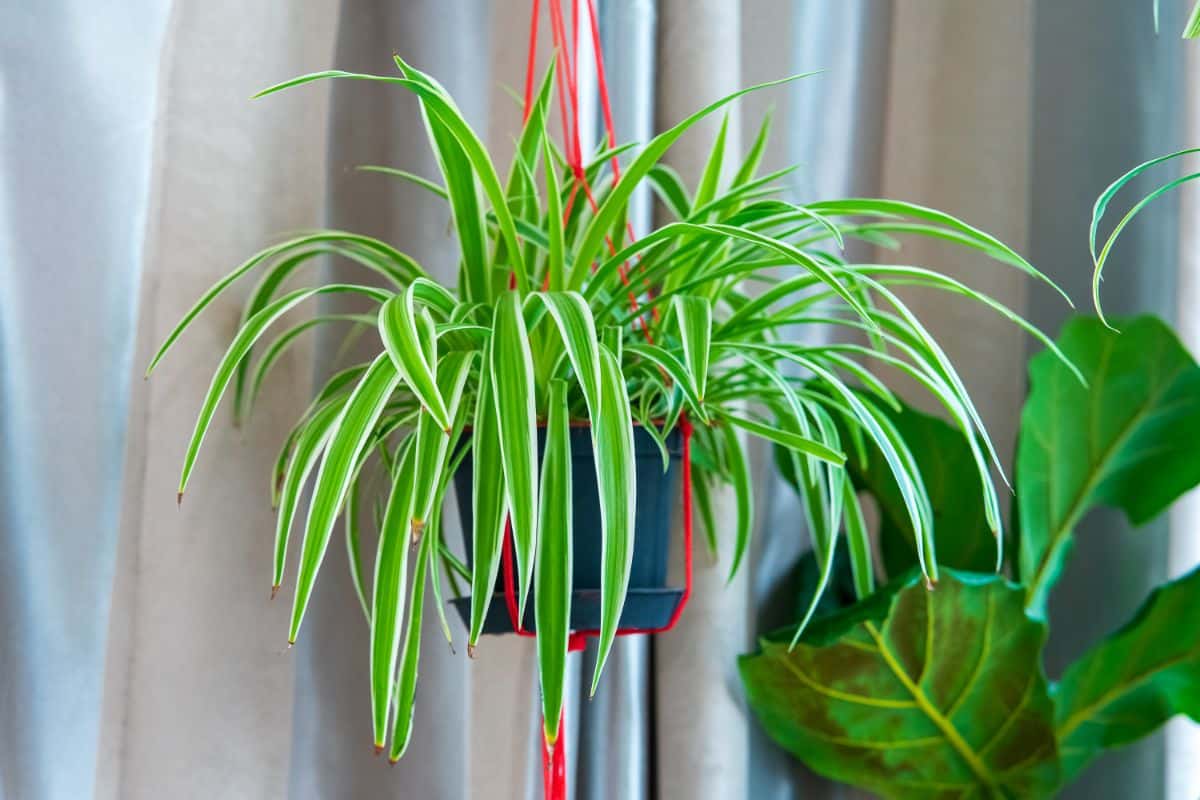
| Plant name: | Spider plant |
| Light requirements: | Bright, indirect light |
| Water requirements: | Moderate |
| Pet safe? | Yes |
| Special features: | Easily propagated; Low maintenance; Pet safe |
The darling of the houseplant world, no plant collection is complete without at least one spider plant. These plants are super easy to cultivate, and even “brown thumbs” should be able to keep spider plants happy. Spider plants also come in both solid green and variegated options, so you’re sure to find a variety to match your style!
As they mature, spider plants will produce tiny, white flowers at the end of long stalks. When those flowers fade, new baby spider plants emerge in their place, which can eventually be potted up on their own if you want more plants. Alternatively, you can leave baby spider plants attached to the parent plant to give your spider plant a fuller appearance in hanging arrangements.
13. String of hearts (Ceropegia woodii)
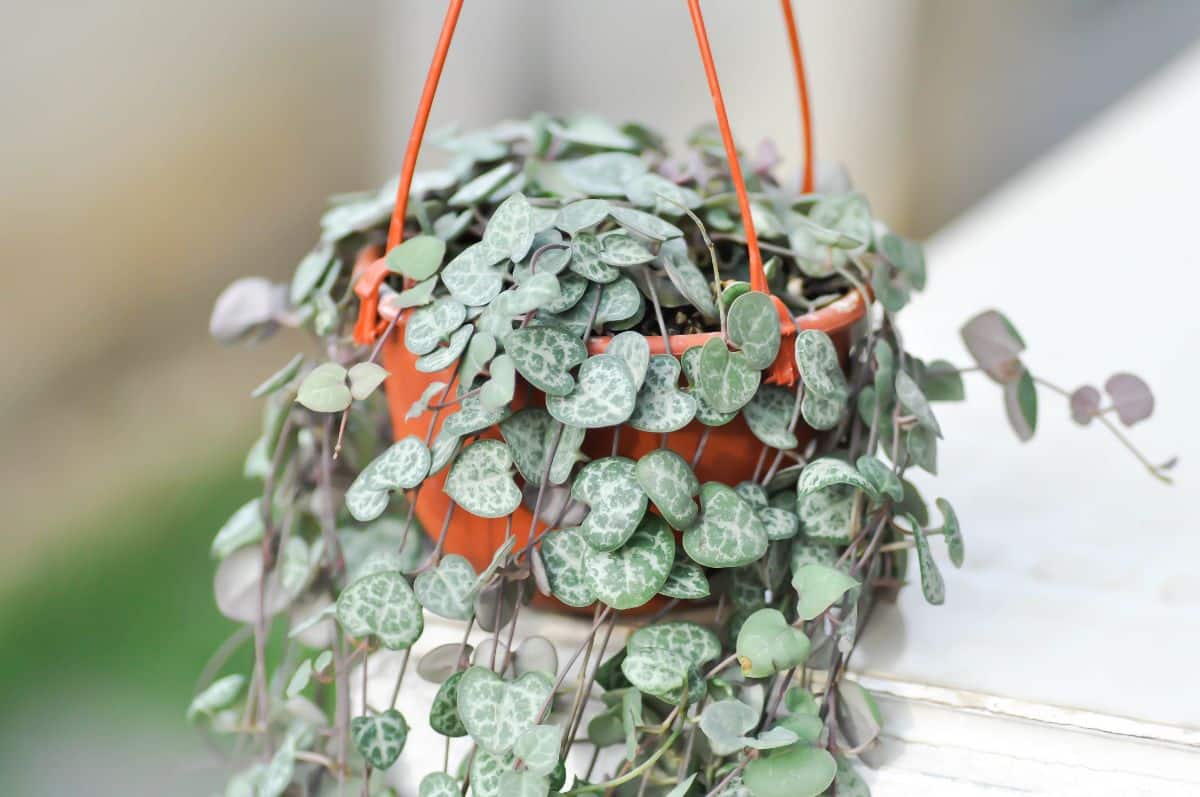
| Plant name: | String of hearts |
| Light requirements: | Bright, indirect light |
| Water requirements: | Moderate |
| Pet safe? | Yes |
| Special features: | Pet safe |
A string of hearts is another gorgeous trailing plant with long, slender stems and adorable, heart-shaped leaves that have a mottled coloration. These plants naturally grow in South Africa, and they can be kept outdoors as a ground cover in warmer climates. However, most plant keepers grow string of hearts indoors in hanging baskets or pots that allow the trailing leaves to cascade gracefully.
Like other “string” plants, a string of hearts has succulent leaves, which are used for water conservation. That said, these plants prefer more moisture than some other succulents, but you’ll need to find a proper watering balance, as a string of hearts can be prone to root rot. Mature plants can grow up to 12’ long, but you can also prune your plant to create a bushier and fuller appearance.
14. Monkey’s tail cactus (Cleistocactus colademononis)
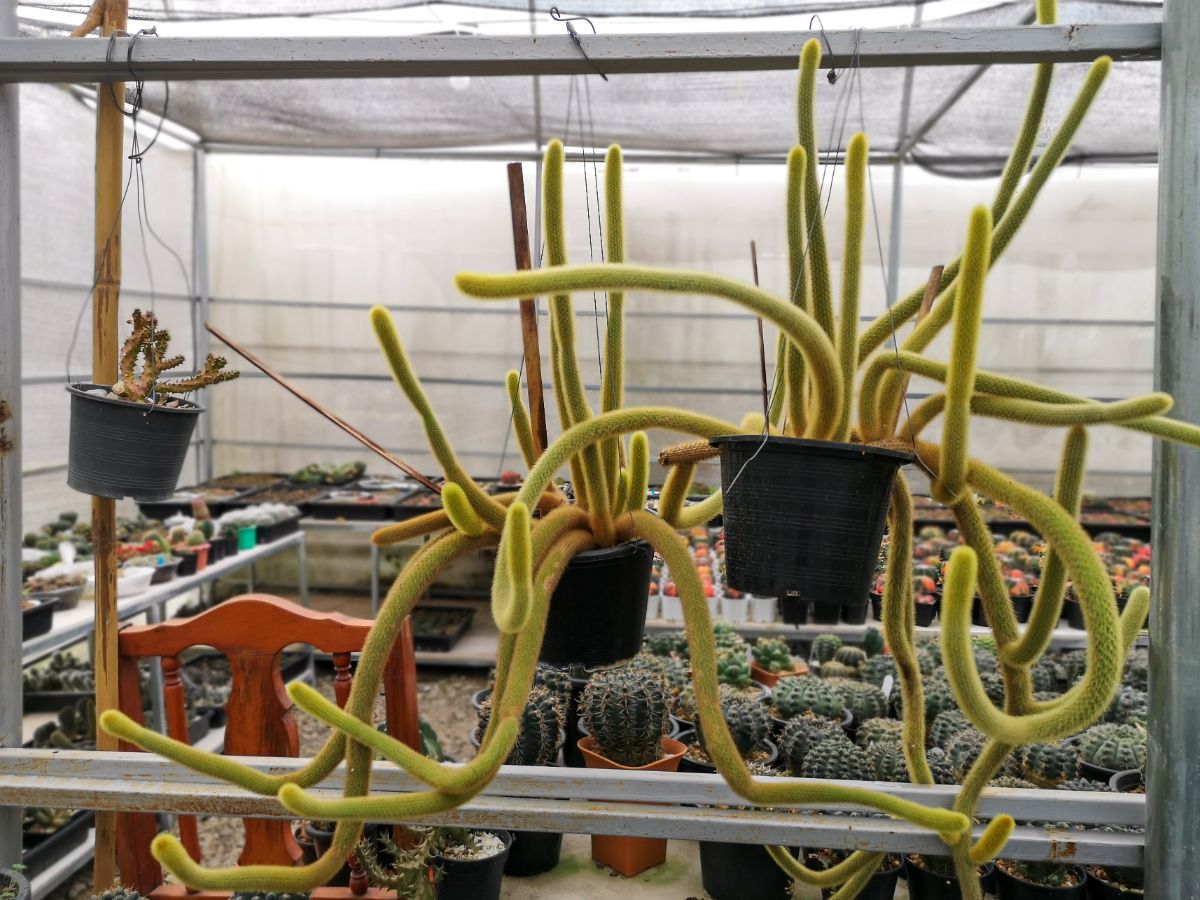
| Plant name: | Monkey’s tail cactus |
| Light requirements: | Bright, indirect light |
| Water requirements: | Low |
| Pet safe? | No |
| Special features: | Low watering needs; Big flowers |
There are several trailing cactus types that look spectacular in hanging baskets, and one popular option is the monkey’s tail cactus. This distinct plant is covered in fine spines that look so soft you want to touch them. But be careful, like many other cacti, monkey’s tail cactuses can prick your fingers!
When mature, the monkey’s tail cactus can bloom bright red, decorative flowers that look a lot like air plants or bromeliad blooms. Once the flowers fade, monkey’s tail cactus also fruits, but the fruit is inedible. Unlike most cactuses, the monkey’s tail cactus is toxic, so it isn’t a great choice for homes with pets.
15. Hoya (Hoya spp.)
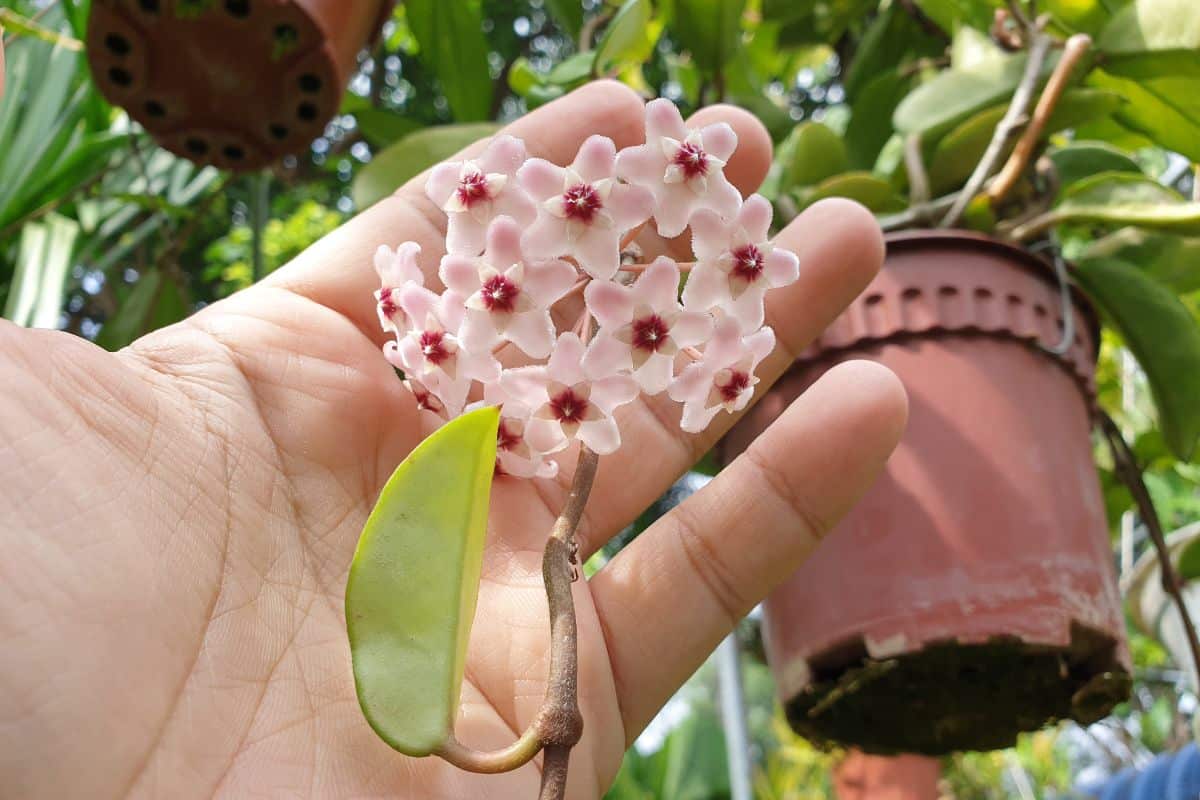
| Plant name: | Hoya |
| Light requirements: | Bright, indirect light |
| Water requirements: | Moderate |
| Pet safe? | Yes |
| Special features: | Big, fragrant flowers; Pet safe |
A close relative of milkweeds, hoyas are mostly known for their oversized clusters of flowers. Hoya flowers exude a sweet fragrance with notes of citrus, chocolate, or vanilla, and the aroma is strongest at night, suggesting these plants are naturally pollinated by nocturnal pollinators in the wild. Hoyas also feature fleshy leaves that feel a bit waxy, which is where these plants get their nickname “wax plants.”
Hoyas are sometimes trained to grow up trellises, but their long vines work well in hanging baskets too. Today, you can find many different hoya varieties for sale, including the ever-popular ‘Sweetheart Hoya,’ the Hindu rope plant, and the colorful ‘Tricolor Hoya.’
16. Burro’s tail (Sedum morganianum)
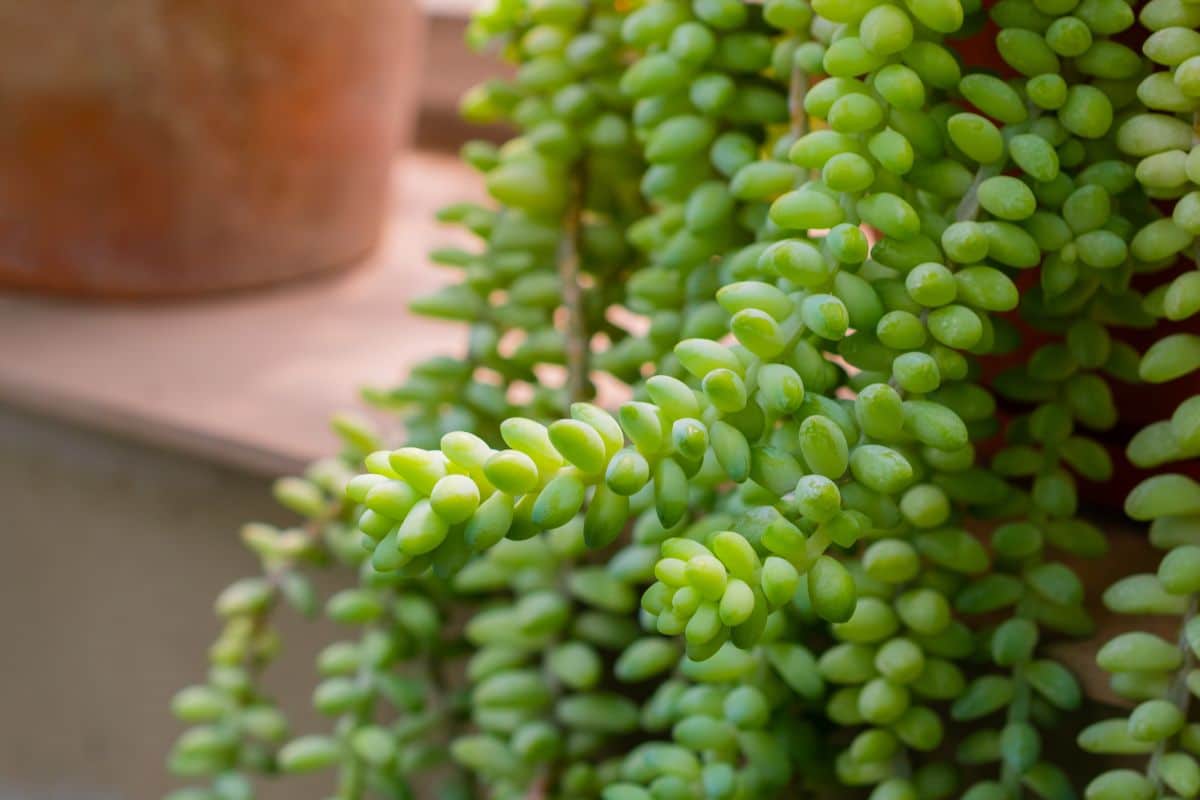
| Plant name: | Burro’s tail |
| Light requirements: | Bright light |
| Water requirements: | Low |
| Pet safe? | Yes |
| Special features: | Low watering needs; Pet safe |
Burro’s tail is a succulent plant with fleshy, blueish-green leaves that grow in tight clusters from the plant’s stems. These plants are sometimes hung outdoors during the summer months to ornament porches and balconies, but they’ll also draw the eye in indoor plant collections.
When kept indoors, the burro’s tail will need lots of bright light to prevent legginess, but it has low watering needs. If you travel frequently or often forget to water your plants, burro’s tail can be a top plant to grow.
17. Fishbone cactus (Epiphyllum anguliger)
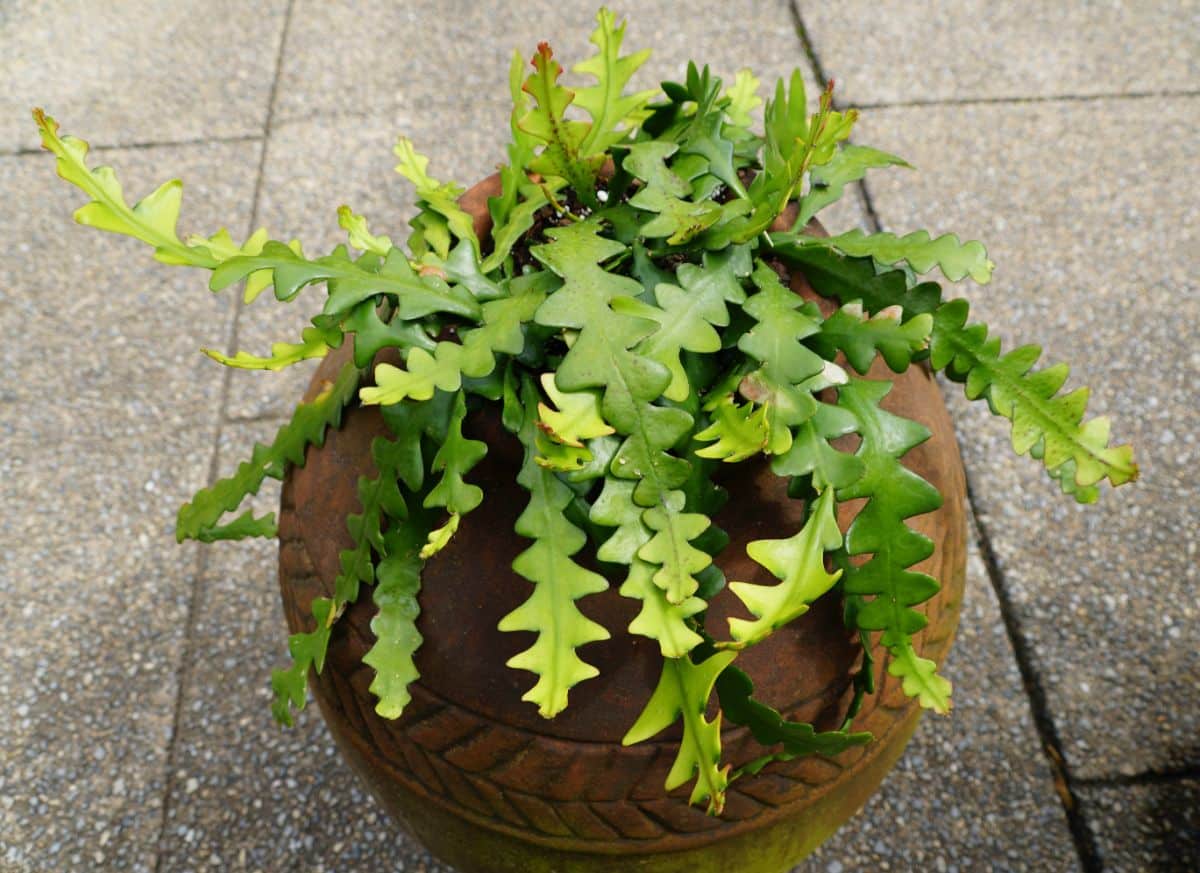
| Plant name: | Fishbone cactus |
| Light requirements: | Bright, indirect light |
| Water requirements: | Low |
| Pet safe? | Yes |
| Special features: | Low watering needs; Pet safe |
Another trailing cactus species, the fishbone cactus, is also sometimes known as the zigzag cactus or ricrac cactus. Whatever name you choose to use, this cactus type has a distinct silhouette with long, flat leaves with highly lobed margins and minimal spines. These cacti can also produce big, showy blooms, but this is rarer with indoor plants and usually requires a period of cool temperatures to jumpstart flowering.
Unlike most other cacti that thrive in dry conditions, fishbone cactuses naturally grow as epiphytes in the tropical jungles of Mexico. That means these plants have higher watering needs than most other cacti, and they’ll also grow best with a bit of extra humidity.
18. Grape ivy (Cissus alata)
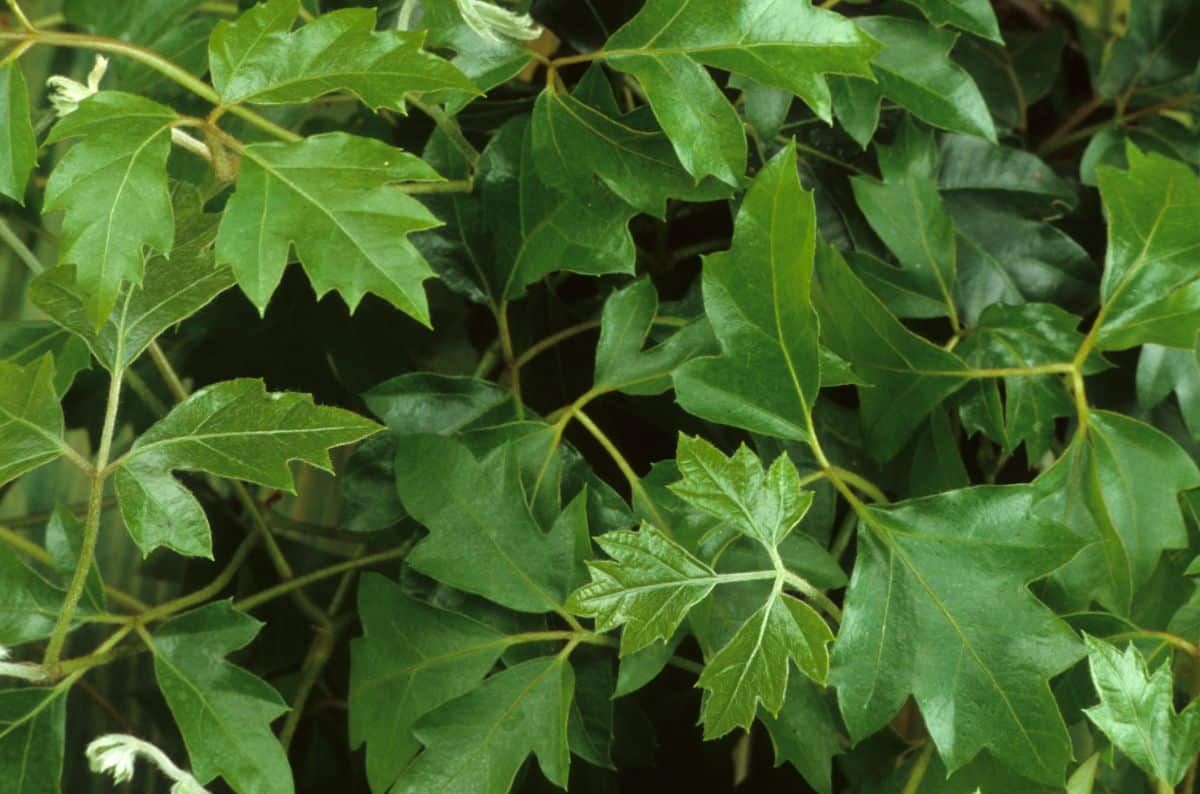
| Plant name: | Grape ivy |
| Light requirements: | Bright, indirect light to medium light |
| Water requirements: | Moderate to low |
| Pet safe? | Yes |
| Special features: | Low watering needs; Pet safe |
If you like the idea of keeping English ivy indoors but you have pets, you may want to try out grape ivy instead. This vining plant has a lot of the same characteristics as English ivy: angular, glossy leaves, and a vigorous growth habit. But it isn’t as unruly as English ivy, and it’s not toxic to pets!
Grape ivy can grow in lower-light situations, and it doesn’t need a lot of water. For healthy plants, allow your grape ivy to dry out a bit between waterings, and only water your plant when the soil feels dry to the touch. After watering, be sure to pour out any extra water in your plant’s saucer so your ivy doesn’t get overly soggy.
19. Pitcher plant (Nepenthes spp.)
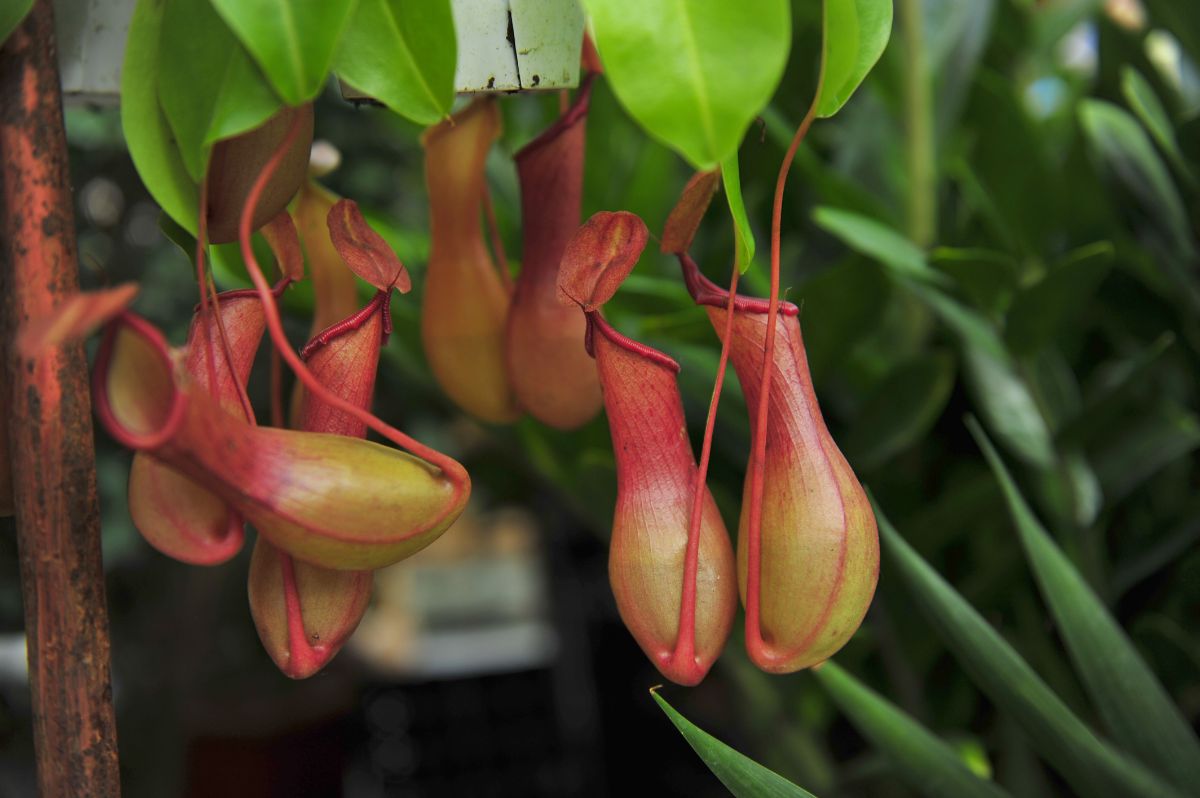
| Plant name: | Pitcher plant |
| Light requirements: | Bright light |
| Water requirements: | High |
| Pet safe? | Yes |
| Special features: | Controls indoor pests; Pet safe |
A fun choice for hanging baskets, tropical pitcher plants have a totally unique look, with cup-shaped pitchers that drape over the edges of pots and planters. Pitchers can range in tone from red and yellow to green, and these plants will occasionally flower, although this is less common.
Like other carnivorous plants, pitcher plants can feed on small insects in your home, providing a natural solution for houseflies and fungus gnats. These plants are native to areas with poor soil, however, so they shouldn’t be grown in a rich potting mix. Instead, plant pitcher plants in potting soil that’s intended for carnivorous plants, and only water your plants with distilled water to prevent minerals and salts from building up in the potting mix.
20. Spanish moss (Tillandsia Usneoides)
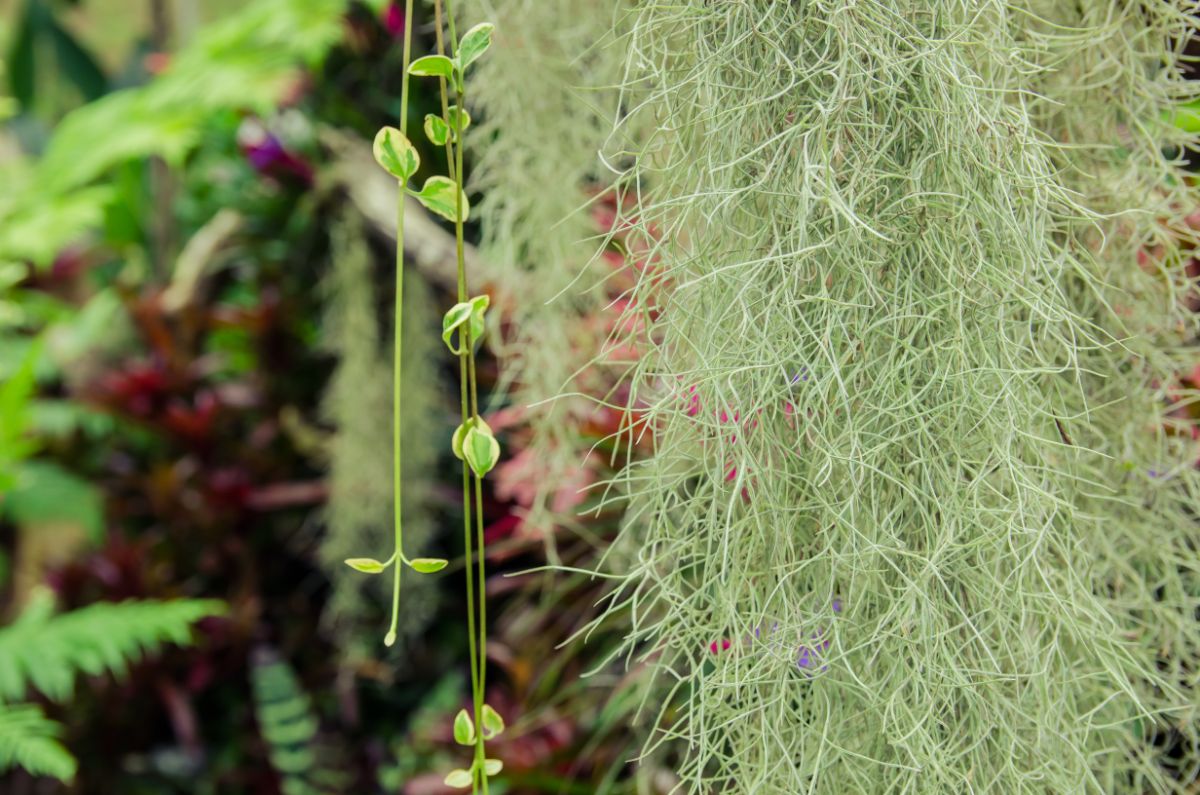
| Plant name: | Spanish moss |
| Light requirements: | Bright, indirect light |
| Water requirements: | High |
| Pet safe? | Yes |
| Special features: | Small space friendly; Pet safe |
Spanish moss is a type of air plant that’s naturally found in the Americas. In the wild, Spanish moss grows as an epiphyte on tree branches and bark, but it can also be kept indoors in hanging baskets or other small planters. Since Spanish moss is smaller than the other plants on this list, it can be hung in tiny pots, or you can get creative and try out DIY planter options, like this sweet sea urchin planter.
Like most other air plants, Spanish moss doesn’t need soil to grow, and it can get most of the nutrients and moisture it needs from the ambient air. However, Spanish moss does love lots of humidity, which makes it a good plant to keep in steamy bathrooms. If you choose to grow Spanish moss indoors, just make sure you get it from a reliable supplier, as wild-harvested moss can sometimes harbor chiggers and other pests.
Summary
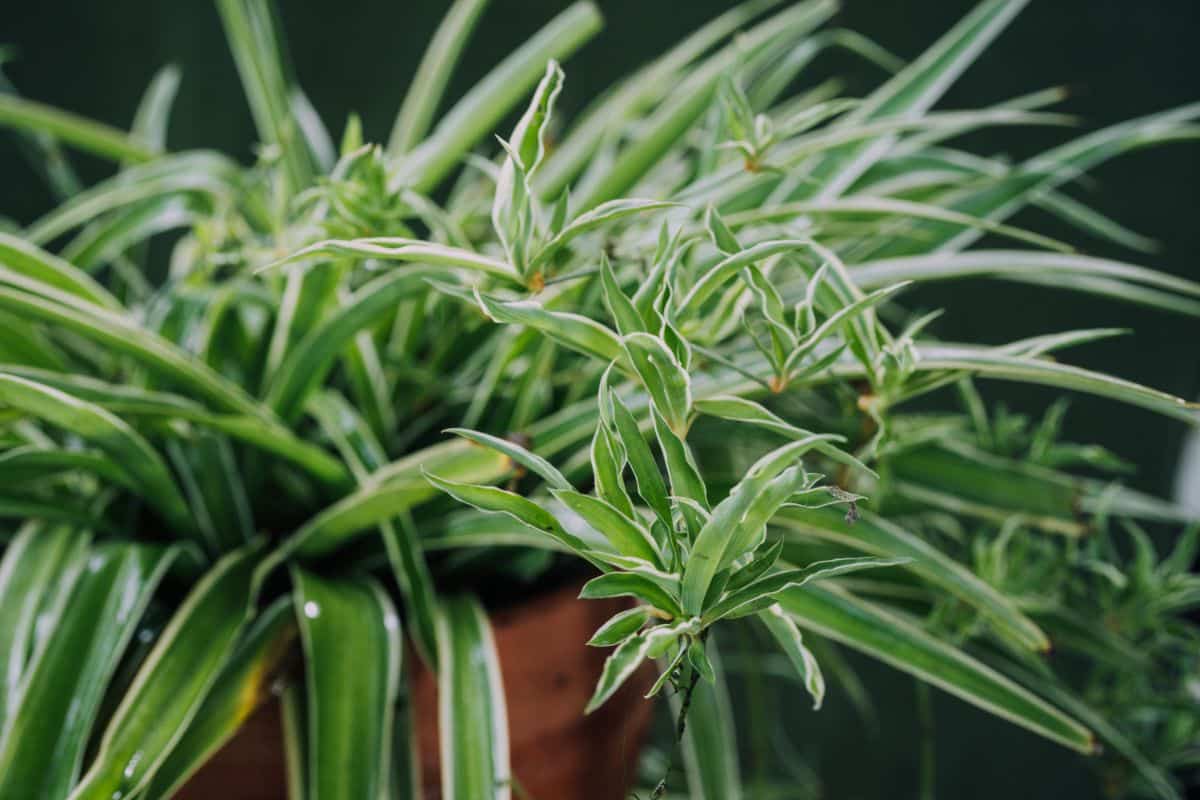
Growing plants in hanging baskets is a great way to utilize vertical space and highlight windows and other architectural features in your home. Keeping plants in baskets also protects delicate plants from wear and tear, and it can also prevent pets and small children from getting into trouble with your plants.
One issue with growing plants in hanging baskets is that plants can be a bit harder to water, and it may be difficult to judge if your plant’s soil is dry. One way to work around this is to grow plants in self-watering planters with visible water gauges. You can find suggestions on the best self-watering planters for hanging plants right here.

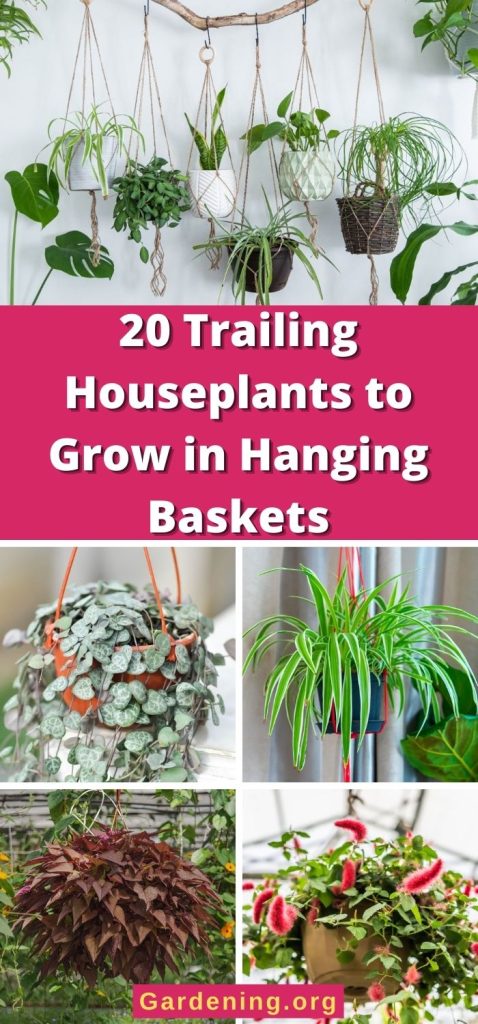
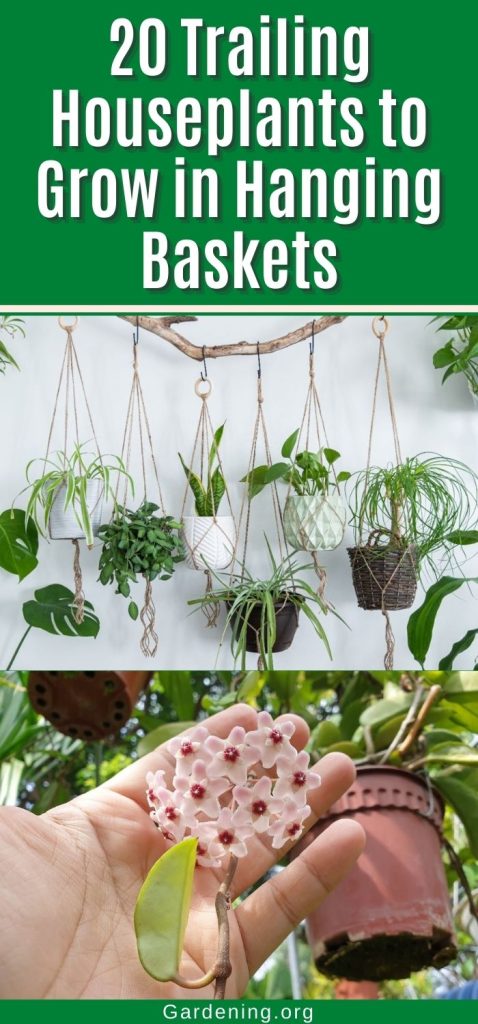
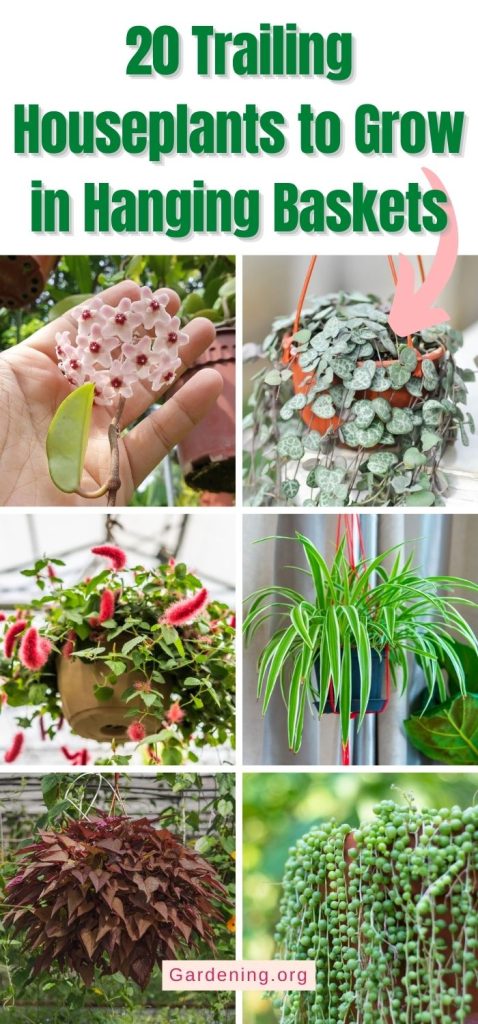
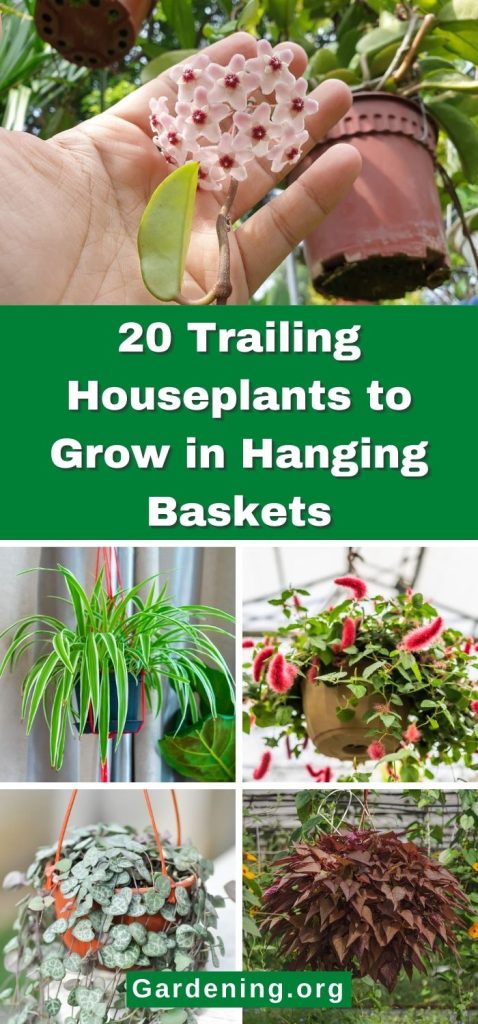
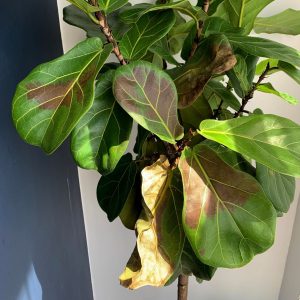
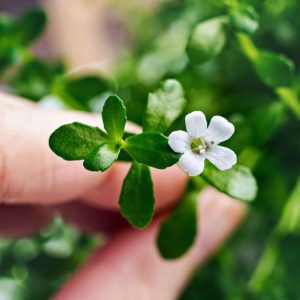
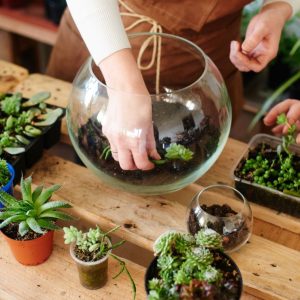
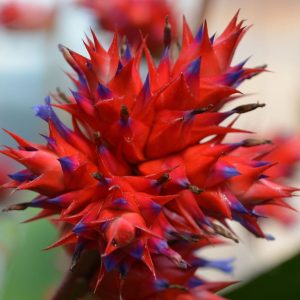
Carmel Haddock
Thank you so much for some fantastic ideas & choices. Great tips for beginners too.